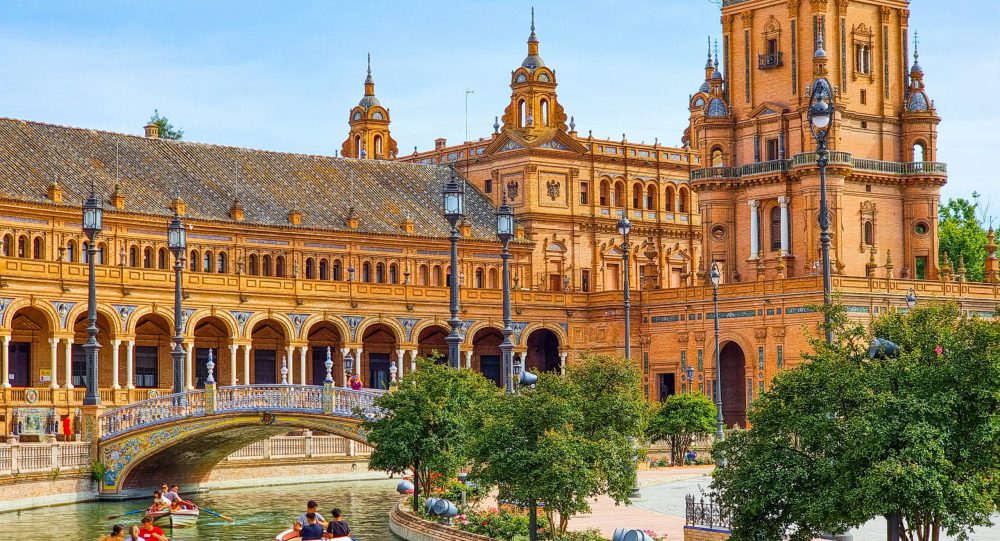What do flour, water, and yeast have in common? They are three individual ingredients that are great on their own but when combined together make the most fresh and delicious bread. This is exactly what the different pieces of Flamenco are like when they come together.
Today was day five in Seville, and we had the privilege of seeing a Flamenco show. Now when they say don’t judge a book by its cover, they mean it, don’t judge a book by its cover. In the first few moments of the performance, we saw the Flamenco dancer dancing alone with the use of her castanets. Her dancing was really good, however, I personally got sick of the repetitive castanet clicks. I assumed the whole performance was just going to be her dancing and using her castanets. That is where I started to get a little worried because I truly did have high expectations for Flamenco and that was not meeting it. We then heard the singer, who notably had a great expression on his face when singing, which I did enjoy. It overall gave the performance more feeling and expression. Unfortunately, it was still not exactly what I was expecting. The guitarist came on stage and performed a solo. I personally really enjoy guitar so this is where things started to take a turn for me.
The show then transitioned from each individual “piece” of Flamenco to a combination of two “pieces.” First, the dancer and singer performed together, then the guitarist and dancer together, and finally, the guitarist and singer together. Hearing each pair perform was a very interesting and unique blend of rhythm, melody, and expression. It felt like the rising action of a fictional novel, which eventually built up to the climax: all three performers coming together in harmony.
I was truly stunned when I heard all three performers. At this point, the whole show exceeded my expectations. When the three Flamenco performers joined, the room was filled with lively noise, covering every inch of the theater. Sounds from the guitar, dancer, and singer blended together so smoothly in a manner that sparked a sense of joy and excitement. It was truly a thrilling show that left everyone amazed by how well they worked together.
During the performance, I couldn’t help but notice how the singer and guitarist kept a close eye on the dancer, making sure they matched her moves perfectly. It showed how well they worked together and how much they depended on each other’s roles. As the dancer danced, the singer’s voice followed along in perfect harmony, and the guitarist played in sync with both of them, making the whole performance feel seamless and cohesive. Seeing this showed me the importance of a cohesive and commutative Flamenco team. If the guitarist was not paying attention to the dancer, he most certainly would have fallen forward or behind her. The same goes with the singer. It was clear that all three of them were in tune with each other, creating a wonderful show for everyone to enjoy.
The costumes worn by the dancer were truly stunning and added so much more excitement to the performance. At first, she wore a more basic black dress which was not my personal favorite. I felt like there was little movement to the dress and the color black made the dance feel like more of a drag. The change into a vibrant red skirt paired with a white blouse and an embellished red hat elevated the visual appeal. I loved how her flowy skirt had lots more movement than the previous dress. It made the dance that much more appealing. The final dress was a gorgeous pink dress with red polka dots paired with a short red vest and flower hair pieces. The bright colors and flowy fabrics of a dancer’s costumes make Flamenco that much more interesting to watch. Both the colors and consistent movement of fabrics catch the eye in a way that is truly a work of art.

After the spectacular Flamenco performance, we then went to a Flamenco school around the corner where Professor Patricia Lozano taught us about each aspect of Flamenco. We first learned about the three different types of “feelings” in a Flamenco performance. First, the Flamenco mode which she explained typically creates more of a mad mood and might even make some people frown. Then, there is the major mode which creates a very sweet, happy feeling and typically makes people smile. Finally, we have the minor mode which is not as deep as the major mode and typically creates a sad feeling. The guitarist is the one who can create these feelings, or modes, to which we heard a student play each of them.
Professor Lozano had one of her dancer students come to show us some Flamenco dances. If there is one thing that truly shocked me this entire day, it was this girl’s ability to dance. I was even more shocked when I later found out she was only 17 years old. Professor Lozano also had one of her singer students come to complete the entire Flamenco performance.
We then went into the different parts of Flamenco and how each part can be interchanged depending on the dancer. The Salidas marks the introduction or greeting, often involving a short piece by the guitarist and singer. Following this, the 1a Letra begins the lyrical aspect of the piece. The Falseta is where the guitarist showcases their skill through a solo melody or short composition. Transitioning back to more lyrics, we have the 2a Letra. The Escobilla is a segment dedicated to the dancer, composed of intricate footwork and accompanied by rhythmic claps. No singing is heard during the Escobilla. Finally, the Cambio closes off the Flamenco performance, starting in one style and seamlessly transitioning to another, often with an increasing tempo but the same rhythm. Together, these components form the structure of a Flamenco performance.
